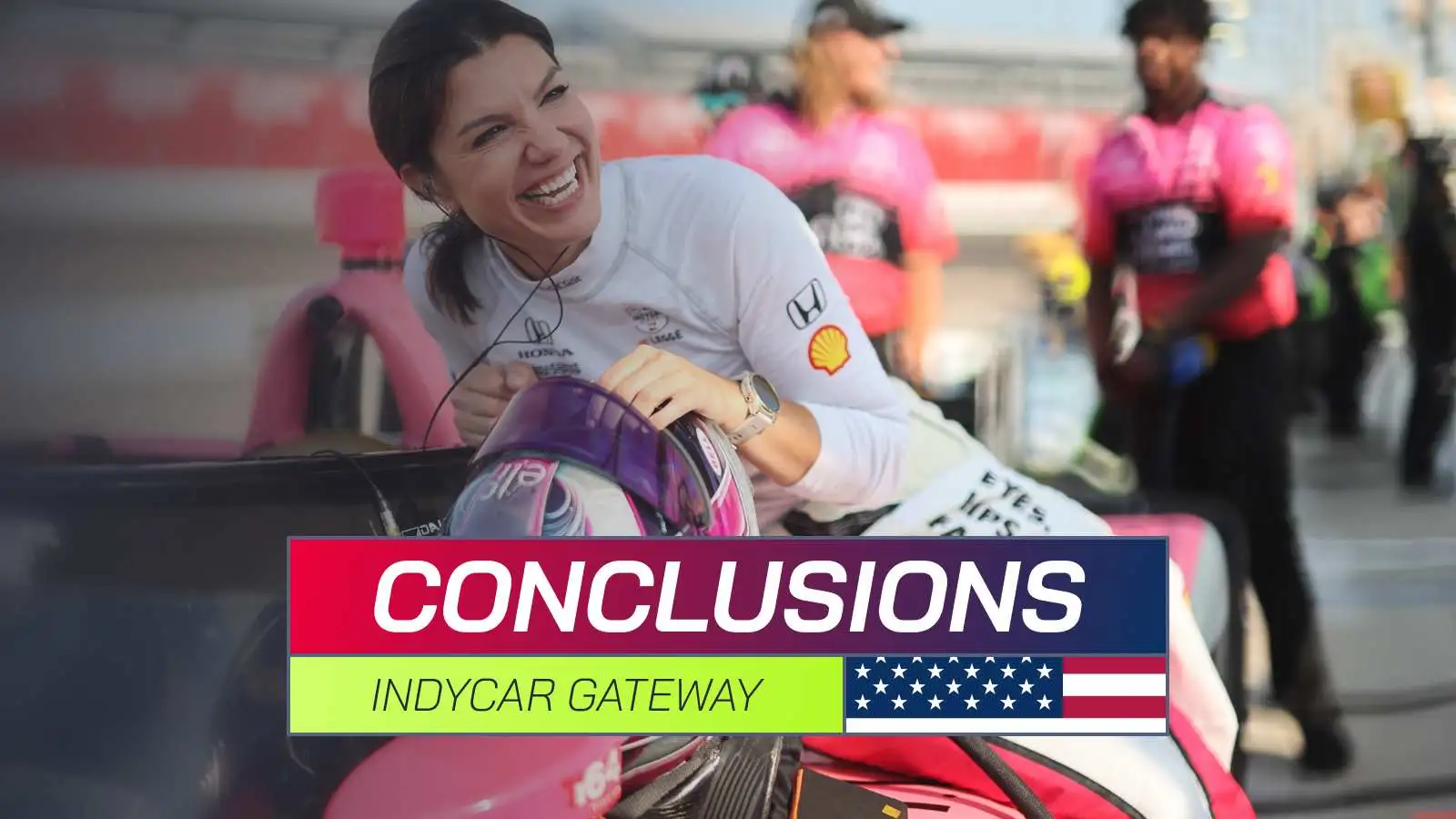IndyCar returned from the Olympic break with a bang at Gateway – and with three ovals remaining this season, the series also promised to shed a light on what could happen the rest of the year.
Team Penske’s Josef Newgarden took the win after a spin, a quick pit stop and a controversially slow restart, but we have a lot more to examine for our IndyCar conclusions.
Conclusions from the IndyCar Gateway
Oval racing is IndyCar’s best party trick
IndyCar oval racing can be very exciting at times, but some tracks, strategies and conditions lend themselves to fairly straightforward single-row racing – but that wasn’t the case this weekend at Gateway.
The Bommarito Automotive Group 500 was a masterpiece of what makes oval racing so great when everything comes together. Several different race strategies were put in place while cars across the field were able to battle hard.
Yes, there were some collisions and a handful of crashes, but beyond everything else, it was an exciting race that should remind fans just how good oval racing can be.
Will that excitement wear off? There are four races left in the season, and three of them are on oval tracks. Those three races are on two different tracks – two events at the Milwaukee Mile, one at Nashville Superspeedway – that only one or two drivers know.
Will this lead to better racing? Or will the new tracks make drivers particularly hesitant? That remains to be seen, but after Gateway there is reason for optimism. IndyCar has found a compelling oval package, and that bodes well for the rest of the year.
Team Penske is hoping to jump to the top of the championship – if it can stop harming itself
Team Penske’s 2024 season was marked by extreme ups and downs. The negative aspects were the cheating-related disqualifications of Josef Newgarden and Scott McLaughlin at the beginning of the season as well as a handful of retirements or poor placings.
The positives: A win at the Indy 500 for Newgarden and impressive wins for his fellow drivers McLaughlin and Will Power.
However, the first part of the IndyCar season was dominated by street and city circuits – and everyone knew that the oval tracks would be Team Penske’s shining example.
However, Newgarden’s slow restart towards the end of the race made him extremely unpopular with teammate Will Power, who was overtaken by a high-speed Alexander Rossi just before the chequered flag.
This change ultimately gave championship leader Alex Palou a much better final position than expected.
Understanding IndyCar:
👉 Formula 1 vs. IndyCar: Comparison of hybrid drives in open-wheel racing
👉 Explained: How McLaren expanded its F1 business to include the IndyCar program
Alex Palou can still win this thing
No, Alex Palou may not have won on an oval track yet, but his fourth-place finish at Gateway means he still has a firm grip on the IndyCar championship in a race where the opposition could have made decisive gains.
Power, Palou’s biggest rival, ended the race in the wall as he was on his way to a podium finish. This move also allowed Palou to gain three places at the finish – and he won another Once, when Herta received a penalty for defending too hard against Linus Lundqvist.
Next up for the IndyCar series is Portland International Raceway, where Palou is expected to dominate. If he can do that, he will enter the final three races of the season – all on oval tracks – with a huge lead. He won’t have to put in a great performance to maintain that lead.
If the season continues as it has so far, Team Penske could actually serve him a title on a silver platter.
Chip Ganassi Racing faces difficult charter decisions
Earlier this week, Penske Entertainment delivered the first official draft of its charter agreement to all 10 full-time teams in the IndyCar Series. While the details are subject to change, Chip Ganassi Racing faces a difficult decision.
With this new charter, each team can only guarantee three cars for each race. CGR, which is fielding five cars this year, will have to carefully select the cars that qualify for a charter and the drivers who will drive them. It will also have to decide whether it is worth running two unchartered cars.
Alex Palou and Scott Dixon are the clear favorites for a chartered car… but who else?
Marcus Armstrong in the No. 11 is the highest-placed of the team’s three other drivers and an eighth-place finish at Gateway would make him even more attractive to CGR’s management.
But Linus Lundqvist’s impressive podium should keep the rookie driver in the race for a chartered car. He has not had as strong results as Armstrong, but he Is a rookie, and he leads the series’ Rookie of the Year standings.
However, there is also Kyffin Simpson. The 19-year-old driver of the No. 4 machine has yet to crack the top 10, and his mistakes – like his uncalled for spin at Gateway – have made him the weakest link in the CGR team.
Simpson, however, brings money with him, and money talks. Can it talk loudly enough to convince Chip Ganassi to put him in a chartered car? We’ll have to wait and see.
Katherine Legge needs a full-time driver to get the most out of the elf sponsorship
The occasional ride in a Dale Coyne Racing machine is no longer enough: if Elf wants to make the most of its sponsorship of Katherine Legge, it needs to find a more reliable full-time driver for her as soon as possible.
Legge has competed in four races in the No. 51 Dale Coyne Racing Honda and her best finish to date is 17th, but that’s largely because her equipment has been challenging.
With her car denied a chance of qualifying due to a mechanical failure at Gateway and limited driving time in practice, Legge was one of the least experienced racers on the track heading into the Bommarito Automotive Group 500. That lack of experience was evident when she ran into the back of Ed Carpenter entering a corner.
It might be easy to simply say that Legge doesn’t have great ability, but I would argue that we simply don’t have enough evidence to prove that – not while she’s riding for Dale Coyne.
DCR has experience in IndyCar racing, but the team’s equipment is not exactly known for its amazing reliability and professional performance.
And that’s especially unfortunate because Legge’s sponsorship of elf cosmetics changed everything. The company’s Indy 500 promotions were impressive because they appealed to a female audience without tokenizing it – a demanding feat.
In addition, Elf also brought a lot of support to IndyCar as a whole and to the races that Legge competed in. But the cars… they left a lot to be desired.
If Elf really wants to make the most of its partnership with Legge, the company needs to find a more reliable car for them in 2025. The sponsor deserves to have its car finish a race.
Read more: IndyCar charters: What we know about the document given to teams at Gateway




